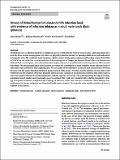Por favor, use este identificador para citar o enlazar a este item:
http://hdl.handle.net/10261/310006COMPARTIR / EXPORTAR:
 SHARE SHARE
 CORE
BASE CORE
BASE
|
|
| Visualizar otros formatos: MARC | Dublin Core | RDF | ORE | MODS | METS | DIDL | DATACITE | |

| Título: | Drivers of Batrachochytrium dendrobatidis infection load, with evidence of infection tolerance in adult male toads (Bufo spinosus) |
Autor: | Bosch, Jaime CSIC ORCID ; Thumsová, Barbora CSIC ORCID; Puschendorf, Robert; Bielby, Jon | Palabras clave: | Body condition Capture-recapture Chytridiomycosis Reproductive effort Temperate areas |
Fecha de publicación: | 5-may-2023 | Editor: | Springer | Citación: | Oecologia 202(1):165-174 (2023) | Resumen: | Chytridiomycosis is affecting hundreds of amphibian species worldwide, but while in tropical areas, adult individuals have been the focus of most investigations, the exact role played by infection intensity of breeding adults is not well understood in temperate areas. We conducted mark-recapture-capture surveys during spiny common toad breeding seasons from 2006 to 2018 at the site of the first recorded outbreak of chytridiomycosis in Europe, the Peñalara Massif (Sierra de Guadarrama National Park, central Spain), and collected infection samples and several variables related to the reproductive effort of male individuals. We used general linear mixed models to evaluate the contribution of study variables on the infection loads of adult male toads exhibited at their capturing date. We also analysed the differences on several male characteristics between the pond with the largest breeding population against the rest of the ponds. We found that the duration of time spent in the waterbody and the condition of the host predicted infection loads. Animals of good physical condition, that spent longer in water, have higher infection levels than individuals with the opposite set of traits. The pond supporting the largest breeding population housed smaller male toads and in poorer condition. Our results are consistent with a shift in reproductive strategy in response to infection and potentially a strategy of tolerance, rather than resistance to infection. These findings have applications for disease mitigation and theoretical implications related to the trade-offs made and the evolution of traits in response to the disease. | Versión del editor: | https://doi.org/10.1007/s00442-023-05380-3 | URI: | http://hdl.handle.net/10261/310006 | DOI: | 10.1007/s00442-023-05380-3 | ISSN: | 0029-8549 | E-ISSN: | 1432-1939 |
| Aparece en las colecciones: | (MNCN) Artículos |
Ficheros en este ítem:
| Fichero | Descripción | Tamaño | Formato | |
|---|---|---|---|---|
| Thumsová_B_Drivers.pdf | artículo principal | 706,56 kB | Adobe PDF |  Visualizar/Abrir |
CORE Recommender
SCOPUSTM
Citations
1
checked on 08-abr-2024
WEB OF SCIENCETM
Citations
1
checked on 27-feb-2024
Page view(s)
25
checked on 23-abr-2024
Download(s)
15
checked on 23-abr-2024
Google ScholarTM
Check
Altmetric
Altmetric
Este item está licenciado bajo una Licencia Creative Commons

